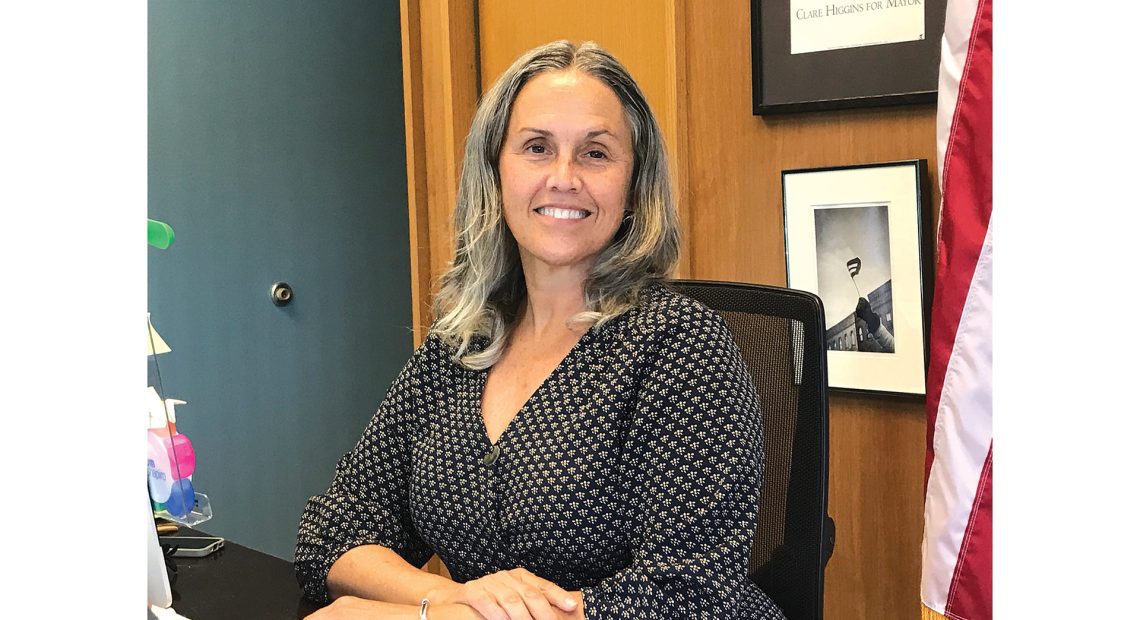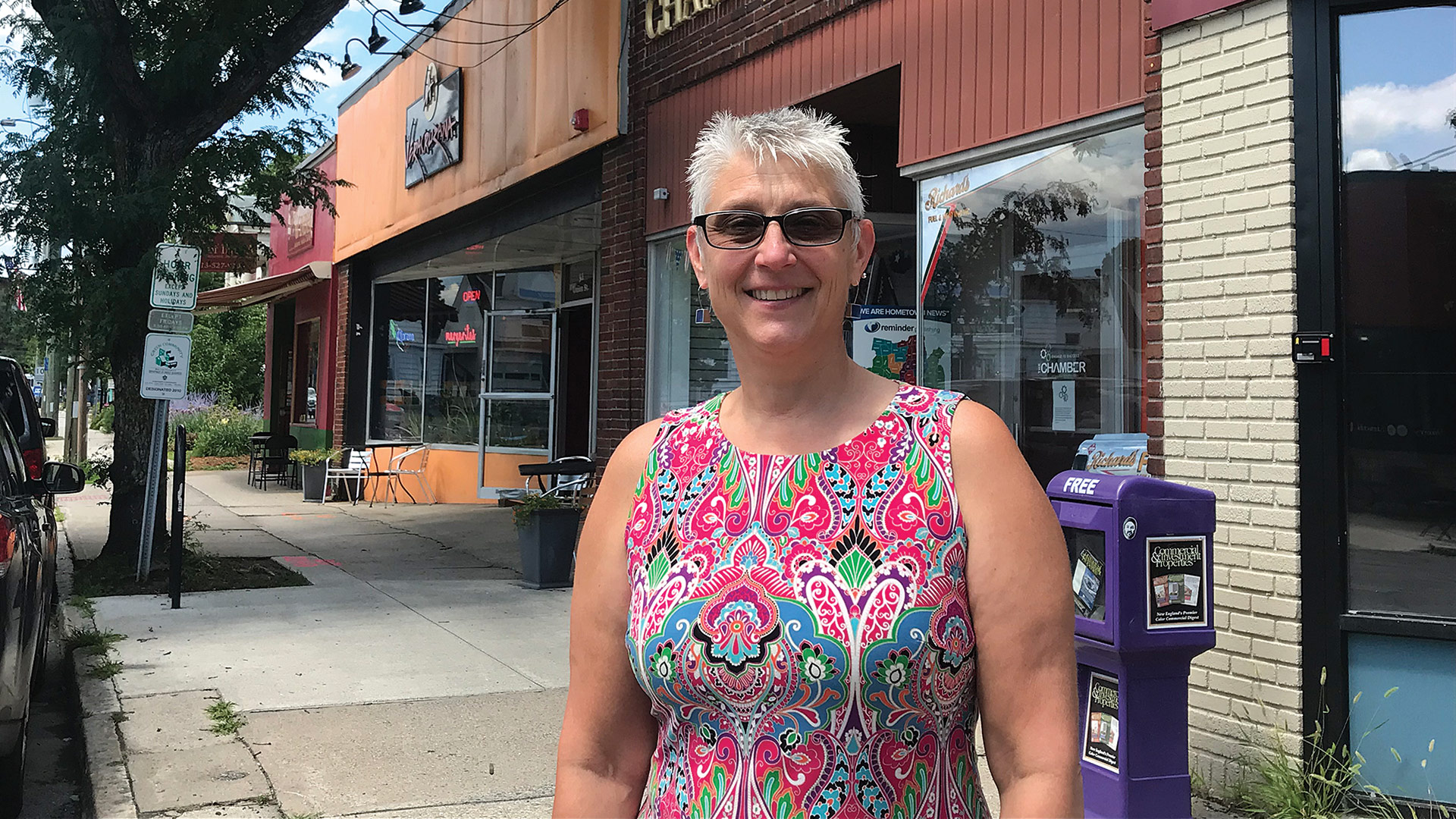
Easthampton Stakes Claim as the ‘Cool-kid City’
Community Spotlight
By Mark Morris

Mayor Nicole LaChapelle’s priorities have included housing, business development, infrastructure, schools, and the emerging cannabis sector.
When people ask Easthampton Mayor Nicole LaChapelle to list her priorities for the city, her answer is always, “housing, housing, housing, and housing.”
And there’s a reason for that — actually, several of them, which LaChapelle summed up in this poignant way: “Easthampton is the cool-kid city.”
By that, she meant that this former mill town has become a destination for businesses, but also a very desirable place to live because of its arts, culture, attractive neighborhoods, and recreational spaces. That mix has created a need for housing — a major need.
“If we don’t put a huge focus on housing, and if we don’t get housing units done by 2025, our city will be in trouble,” said the mayor, adding that her administration has, indeed, focused significantly on this issue, and it has yielded results, such as the One Ferry project, an initiative that is creating not only new housing but retail and office space as well.
Several old mill buildings on Ferry Street are undergoing a massive effort converting the former factories there to condominiums and rental housing, as well as some retail and office space.
So far, the renovation work has focused on three buildings: 3 Ferry St. was finished in 2020, and it is now fully occupied with residents and several businesses. Meanwhile, 5 Ferry St. consists mainly of apartments with condominiums on the top floor; it is expected to open later this year.
“All but two condos are sold at 5 Ferry St., and the developer reported a 65% lease rate,” LaChapelle said, adding that “70% occupancy is usually the goal for a new development, so they are right there.”
Work has also begun on Building 7, scheduled to open in 2024. When complete, the three buildings will add nearly 150 units of housing to Easthampton.
“The Ferry Street project is what we hoped it would be, a spark for community development and neighborhood pride,” the mayor said. “Watching the progress at the site has been a real confidence booster for the city.”
While housing is indeed a priority, it is just one of many priorities in a community that has seen a great deal of change, evolution, and growth over the past quarter-century, and is poised for more of all the above.
“COVID was a huge challenge for businesses. This site allows them to respond to those challenges and to build more resiliency for changes in the future.”
Other focal points for LaChapelle and her administration include new business development, business-sector recovery from COVID, infrastructure, schools, growth of the city’s emerging cannabis sector, and more, and the mayor reports progress on all these fronts, especially those involving assistance and mentoring to small businesses.
Many are included in a broad initiative called Blueprint Easthampton. Designed to promote entrepreneurial innovation, the initiative also emphasizes partnerships with key constituents in the community such as nonprofit organizations and educational institutions.

Keith Woodruff was one of the first local business owners to open an online store on the Shop Where I Live site.
LaChapelle said Blueprint Easthampton is like an octopus in the way it keeps reaching out to different areas. One notable partnership is with the Coalition for Community Empowerment, a collaboration with the Massachusetts LGBT Chamber of Commerce, the Black Economic Council of Massachusetts, and Lawyers for Civil Rights. They have embarked on a statewide program to provide small-business technical assistance and open paths to entrepreneurs from at-risk populations. LaChapelle said at least a dozen businesses in Easthampton have benefited in some way from this effort.
“At a deeper level, three businesses have received grants, and two others have signed up for extensive business coaching,” LaChapelle said, explaining that startup businesses often have to realign their ideas to serve the market that exists.
“In one case, a baker had a business plan based on a delivery and storefront model,” she noted. “After coaching from the coalition, she realized her idea would work better without the storefront.”
For this, the latest installment of its Community Spotlight series, BusinessWest takes an in-depth look at Easthampton, the many forms of progress being seen there, and what’s next for the ‘cool-kid city.’
‘Shop Where I Live’
In January, LaChapelle began her third term as mayor. Unlike her previous terms, which each lasted two years, the mayor’s term now runs four years. It’s a change that makes long-term planning easier on many fronts.
“With a four-year term, the mayor isn’t distracted with campaigning after only 18 months,” she said. “The longer term also makes it easier to manage the timing of grant cycles.”
The longer term is beneficial when coping with pressing issues, said LaChapelle, adding, again, that there are many of them, especially in a community that has become home to small businesses across many sectors, from technology to the arts to hospitality, that were negatively impacted by the pandemic.
In partnership with the Greater Easthampton Chamber of Commerce, the city secured a grant from the state’s Rapid Recovery Plan, which was set up to address the economic impact COVID-19 had on cities and towns. The grant resulted in an online retail effort run by the chamber known as easthampton.shopwhereilive.com.
Moe Belliveau, executive director of the chamber, explained that the Shop Where I Live program is an Amazon-type experience involving local businesses.
“Many businesses don’t have the resources or the time to set up online shopping, so this site makes that possible,” she said.
Consumers can choose offerings from several local businesses, put them all into an online shopping cart, and make one payment. Because the site is supported by a state grant, it’s open to all Easthampton businesses whether they belong to the chamber or not.

Moe Belliveau said Shop Where I Live will help businesses respond to economic challenges both now and in the future.
“For members, this will be an ongoing benefit,” Belliveau said. “For non-members, the first year is free, then they can choose to join the chamber or pay a service fee to remain on the site.”
Each merchant can offer up to 100 products in their online store, said Belliveau, adding that Shop Where I Live is not restricted to retail operations. Services such as health clubs, web developers, and insurance agents can be found there, too.
“COVID was a huge challenge for businesses,” Belliveau said. “This site allows them to respond to those challenges and to build more resiliency for changes in the future.”
KW Home, an interior-design firm and retail showroom, was one of the first businesses to open an online store on Shop Where I Live. Owner Keith Woodruff expects the site to benefit his business going forward.
“For the last two years I’ve had to operate by appointment only with limited hours,” he explained. “Many consumers are still concerned about shopping in person, so having the online store will be a big help.”
KW Home is an example of a business that provides a service and sells products. Most of Woodruff’s work is driven by working with clients to present design plans specific to their homes and then providing the furniture, lighting fixtures, and other items to execute the plan.
He said 80% of what he sells are special orders for clients. Most items run the gamut from a specific type of fabric for a chair or couch to custom window treatments. He also carries items in limited fabric offerings that are more easily available and work well with the online store.
“In order to make the launch date of June 30, I put only a few items on the site,” Woodruff said. “As this rolls out, I plan to add smaller accessories on there to give people more choices.”
Work in Progress
One of the many disruptions COVID caused was the nature of where people work. Even now, some people have returned to their worksites, some continue to work from home, while others have left their jobs to pursue the business idea they’d always wanted to try.
Amid these changing dynamics, Belliveau conducted research on how best to use the space at the chamber office on Union Street. The result is a new co-work space called Work Hub on Union.
“We’re looking to address folks who still work from home but need a temporary space, as well as entrepreneurs who are just starting out but are not yet ready for a permanent space,” said Belliveau, adding that the chamber will remain on site, so those in Work Hub can benefit from its support.
“We are designing this so the furniture can be moved around to create educational space,” she explained. “We’ll be able to run things like development programs and entrepreneurial support programs. In short, it’s a much more productive use of the space.”
While inclusivity is a big part of Blueprint Easthampton, so is accessibility. Working with two land trusts, the city recently bought 22 acres of land near Mount Tom that connect to state-owned property. The purchase was intended to save the land from development. Instead, that area will soon have an ADA-accessible trailhead that goes up to the summit of the mountain.
“I ran on improving accessibility for everyone, so this project makes me very proud,” LaChapelle said.
Riverside Industries was a partner in the trail project. Located in the center of Easthampton, Riverside’s mission is “empowering people of all abilities to help them achieve their highest potential and live their best lives.” It is best-known for placing people with intellectual and developmental disabilities into employment throughout Hampshire, Hampden, and Franklin counties.
Lynn Ostrowski Ireland, president and CEO of Riverside, said anyone can use the new trail because it can accommodate manual or electric wheelchairs, and the ascent along the trail is no greater than the inclines in Riverside’s Cottage Street headquarters.
As someone who has previewed the trail, Ostrowski Ireland reported the summit view is “beyond spectacular.”
“There are plenty of places along the trail to pull off and take a break or just to stop and enjoy the view along the way,” she said. “We will definitely bring clients there and let their families know about it, too. It’s really something everyone can enjoy.”
Natural surroundings like Mount Tom are part of the attraction for new students at Williston Northampton School. The private college-prep school approaches the fall with a full enrollment. Ann Hallock, director of communications at Williston, said 495 students will be on campus, hailing from all over the U.S. as well as 30 different countries.
“We consider our location in Easthampton to be a unique selling point of the school,” Hallock said. “Students love the location, especially being able to walk into town for restaurants or visit shops or go for hikes on Mount Tom. Parents like all that too when they come to visit their kids.”
Williston students also get involved with several local organizations, such as the Easthampton Community Center and the Emily Williston Library.
When classes begin in the fall, the new Mountain View School, housing students in grades K-8, will be fully open to all its students. As the finishing touches were added this year, middle-school students moved in during the spring. Now that construction is complete, the elementary students will begin their classes at Mountain View in the fall.
With the new school project done, LaChapelle has shifted her attention to finding a reuse for the Maple Street, Center, and Pepin schools, the three buildings replaced by Mountain View. Later this summer, the mayor will issue a request for proposals that she hopes will attract the attention of developers who are planning their next construction season.
Naturally, the mayor would like to see the buildings turn into housing.
“Depending on how they are developed, the three buildings could add as many as 150 rental housing units,” she said. “Realistically, we’re hoping to see 70 to 80 units get added to the housing rolls, with 20% to 25% of those designated affordable.”
The search for a developer comes after 18 months of residents working with a consultant to determine the needs and wishes of each neighborhood where the schools are located.
“It’s exciting because every step of the way, we have been talking with residents about the buildings,” the mayor said. “The residents have done an amazing job, and after all their input, it’s safe to say the people have spoken.”
When the people spoke and voted to allow cannabis sales in Easthampton, no one knew what the impact might be on the city. In the beginning, there were fears of higher crime, underage use of cannabis, and fire-suppression issues in the shops. Now, with five dispensaries operating in the city, LaChapelle said none of those concerns came to pass.
Instead, the biggest effect was increased wear and tear on their roads.
“The revenue we’ve received from cannabis has largely been spent on our roads because they have been heavily impacted with the additional traffic,” she told BusinessWest.
The mayor added that it’s actually good news that the impact was on roads because many of them weren’t in good shape before cannabis came to town.
“We had to reprioritize which roads get paved because suddenly there are thousands more people driving on these roads,” she said.
Bottom Line
Now that the city is in a good place with its budget and has improved its bond rating since COVID, LaChapelle is reflective on how far Easthampton has come.
“I’m super proud of the people in our city departments and their leaders in how they’ve taken all our projects head on,” she said. “I feel we haven’t dropped any of the balls we were juggling before COVID.”
She quickly added that, because Easthampton is such a desirable place to live, there’s plenty of work to be done going forward.
That’s the reality when you’re the ‘cool-kid city.’




